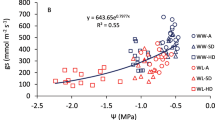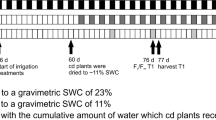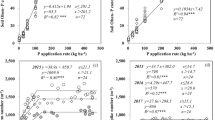Abstract
Walpole and Morgan1 have suggested that differences in absolute growth rates between grains at different spikelet nodes in barley result from differences in quantity of assimilate supplied by each subtending awn, and that this quantity varies in proportion to awn size. They assume implicitly that awns affect grain growth rates by functioning solely as additional assimilate sources. If this is so, then differences in awn size between different nodal positions could determine these growth rate differences only if the assimilate requirements for grain growth were in excess of the total potential pool available for grain growth. Results from other work2,3 suggest that in barley (as in wheat4,5) the converse situation may occur. From studies of temperature effects on the relationship between grain growth and leaf area duration6,7 and on CO2 exchange rates8 in barley, it is a reasonable supposition that under the ‘cool greenhouse’ conditions used by Walpole and Morgan (with presumably a high light intensity and adequate water supply) the potential assimilate supply may have exceeded the grain growth demand in their plants. Support for this hypothesis is provided by their data as these show no evidence of any competition for assimilate between grains such as might be expected if demand had exceeded supply. If grain growth rates were not limited by assimilate supply, then either awns did not affect them or they did so primarily by affecting potential growth rates independently of assimilate supply, that is, by influencing the ‘sink demand’ (or ‘sink capacity’) of each grain.
This is a preview of subscription content, access via your institution
Access options
Subscribe to this journal
Receive 51 print issues and online access
$199.00 per year
only $3.90 per issue
Buy this article
- Purchase on Springer Link
- Instant access to full article PDF
Prices may be subject to local taxes which are calculated during checkout
Similar content being viewed by others
References
Walpole, P. R., and Morgan, D. G., Nature, 240, 416 (1972).
Buttrose, M. S., and May, L. H., Aust. J. biol. Sci., 12, 40 (1959).
Willey, R. W., and Holliday, R., J. agric. Sci., Camb., 77, 445 (1971).
Puckridge, D. W., Aust. J. agric. Res., 19, 711 (1968).
Evans, L. T., and Rawson, H. M., Aust. J. biol. Sci., 23, 245 (1970).
Thorne, G. N., Ford, M. A., and Watson, D. J., Ann. Bot., 31, 71 (1967).
Welbank, P. J., Witts, K. J., and Thorne, G. N., Ann. Bot., 32, 79 (1968).
Ormrod, D. P., Hubbard, W. F., and Faris, D. G., Can. J. Pl. Sci., 48, 363 (1968).
Bingham, J., Agric. Prog., 44, 30 (1969).
Wardlaw, I. F., Aust. J. biol. Sci., 23, 765 (1970).
Asana, R. D., and Bagga, A. K., Indian J. Pl. Physiol., 9, 1 (1966).
Michael, G., Schultz, R., and Wagner, H., Flora, Jena, 160, 306 (1969).
Michael, G., Allinger, P., and Wilberg, E., Z. Pfl-Ernähr. Düng. Bodenk., 125, 24 (1970).
Michael, G., and Seiler-Kelbitsch, H., Crop Sci., 12, 162 (1972).
Wheeler, A. W., Ann. appl. Biol., 72, 327 (1972).
Pavlov, A. N., Lobanova, N. V., and Kolesnik, T. I., Soviet Pl. Physiol., 18, 709 (1971).
Frey-Wyssling, A., and Buttrose, M. S., Nature, 184, 2031 (1959).
King, R. W., Wardlaw, I. F., and Evans, L. T., Planta, 77, 261 (1967).
Wareing, P. F., Khalifa, M. M., and Treharne, K. J., Nature, 220, 453 (1968).
Treharne, K. J., Stoddart, J. L., Pughe, J., Paranjothy, K., and Wareing, P. F., Nature, 228, 129 (1970).
Author information
Authors and Affiliations
Rights and permissions
About this article
Cite this article
HOLMES, D. Physiology of Grain Filling in Barley. Nature 247, 297–298 (1974). https://doi.org/10.1038/247297a0
Received:
Revised:
Issue Date:
DOI: https://doi.org/10.1038/247297a0
This article is cited by
Comments
By submitting a comment you agree to abide by our Terms and Community Guidelines. If you find something abusive or that does not comply with our terms or guidelines please flag it as inappropriate.



